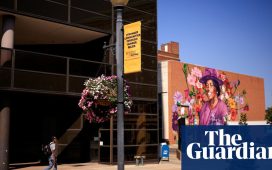Every week, two converted blue buses stocked with children’s books carefully navigate the streets of Kabul, avoiding areas where deadly explosions are common. These travelling libraries stop off at schools in different parts of the city, delivering a wealth of reading material directly to youngsters who have limited access to books.
“A lot of schools in our city don’t have access to something as basic as a library,” says Freshta Karim, a 27-year-old Oxford University graduate who was inspired to start Charmaghz, a non-profit, in her home city having grown up without many books herself. “We were trying to understand what we could do to promote critical thinking in our country.”
While for many commuters a bus or train journey presents a rare opportunity to get stuck into a book, in some cities public transport is being commandeered as means of getting books to communities that need them most. Vehicles are being reimagined and upcycled to not only to spread the joy of reading, but to educate and improve lives.



Afghanistan, for example, has one of the world’s lowest literacy rates, with only three in 10 adults able to read, according to Unesco. The majority of public schools in Kabul do not have libraries and the city’s libraries do not offer many children’s books.
For Karim, buses were a cost-effective, efficient way to get books to children. Charmarghz rents them from a state-owned bus company. “We go to nearby schools,” she says. “We try to stop inside communities rather than on the main streets where explosions often happen.”
The organisation is funded by donations from local business and communities, and also boasts a third bus that acts as a mobile cinema. Over 600 children visit the buses each day to read, socialise and play games. “They are often very excited,” she says. “One of our biggest challenges is that so many children want to come inside the bus, we can’t have all of them in one day.”

-
A bus converted into a library and classroom by California’s Yes We Can organisation, in Tijuana, Mexico. Photograph: Norbert Tsi/Yes We Can World Foundation
On the other side of the world, in Tijuana, Mexico, another bus has been similarly transformed – this time for migrant children, whose families have come from countries such as Honduras and El Salvador to escape violence or poverty.
The city is a popular destination on the migrant trail as it lies south of California where the courts tend to be more welcoming than in places such as Texas, so people have a higher chance of being granted asylum in the US, says Estefania Rebellon, founder of the Yes We Can World Foundation, which runs the bus school. “The reason we decided to put the first school there is because Tijuana is a go-to migrant destination where the caravan from 2018 landed and where thousands still travel to in the hopes of seeking asylum,” she says.
The school chose a location next to a shelter for families, as children make up 60% of the resident population. Many families remain at shelters for months waiting to apply for asylum.



-
The school teaches reading, writing, maths and science; the children also receive emotional support to help them cope with the challenges they face. Photographs: Jorge Dueñes/Reuters/Norbert Tsi/Yes We Can World Foundation
Rebellon was inspired to set up the school after volunteering at a Tijuana refugee camp. “I saw kids running around without shoes, just malnourished and not having anything to do,” she says. “We needed a fast solution to an urgent problem.”
The Trump administration’s immigration policies force them to spend long periods in limbo, says Rebellon, who had her own migrant experience as a child when her family fled Colombia for the US. “They can’t work, they can’t rent a place and the kids can’t be registered in schools because they don’t have a status.”
As well as reading and writing (the school is often the children’s first introduction to English) and maths and science, the children receive emotional support to help them cope with the specific challenges they face. “We try to equip them with as many tools as they need in their situation,” she says. “We talk about what’s appropriate for kids as far as their own personal space, because unfortunately there’s a lot of sexual abuse towards children on their migrant journeys.”
The school also provides children’s storybooks about migration, such as Lola by Junot Diaz, and gives the pupils uniforms and backpacks full of school supplies. There are 45 kids at the school, with a further 30 about to be enrolled, and Yes We Can is fundraising for a second mobile school. Rebellon says: “As the days go by you see the change in the kids that arrive. They really feel they are in a safe space.”

It is not only buses that are being converted into libraries. In Tel Aviv it is the vast and dilapidated central bus station that is the unlikely setting for a Yiddish cultural centre and library containing around 60,000 books.
It’s run by Mendy Cahan, an actor and singer whose love for the Yiddish language inspired him to put together the collection, ranging from Yiddish poetry, prose and science books to newspapers.
A number of factors have led to the decline of Yiddish over the last century, the most significant being the Holocaust, in which millions of Yiddish-speaking Jews were killed. Yiddish was further marginalised when Hebrew became the official language of Israel. “Modern history has been very unkind to Yiddish,” says Cahan, an expert who worked on Son of Saul, the Oscar-winning film set in Auschwitz, translating the dialogue into Yiddish and training the actors to speak it.

He began his collection after struggling to find Yiddish books in bookstores and subsequently set up Yung Yiddish, a not-for-profit to preserve Yiddish culture. The bus station was one of the only affordable spaces large enough to house his books. Cahan believes the location is apt. “We are a people that travelled a lot,” he says. “For a cultural centre to be in a place where people move is a good thing.”
The library, which also hosts events, concerts and language classes, attracts visitors from a cross-section of communities in Israel. “People from traditionally dressed orthodox Hasidim [Hasidic Jews] to youthful anarchistic leftists or LGBTQ people. They like this place, they’re attracted to it in different ways,” he says.
With the audible rumbling of buses overhead, Cahan concedes it’s a strange place for a library, but for him the surrounding bustle is a positive. “I feel the urban beat coming through the buses and the travellers. They add a dimension to the experience.”
Other book initiatives on public transport
• Comic books were left on trains, buses, trams and underground systems in cities around the UK earlier this month to mark 80 years of Marvel Comics.
• A tram in Bucharest recently hosted an interactive poetry library where passengers were able to read poetry books written by Romanian authors and listen to jazz.
• Carriages on two subway trains in Beijing were turned into audio book libraries where passengers could download books. To give the train the feel of a library, the walls of the carriages were decorated with book covers and made to look like bookshelves.
• People in the Netherlands get to travel on trains for free during the country’s annual book week celebrations. Passengers can present a novel instead of a rail ticket.
• In the Greek city of Thessaloniki, the transport ministry installed mini libraries at bus stops to allow commuters to read as they wait for the bus, or borrow and read on their journey to be returned at a later date.
• Passengers on New York’s subway can download free short stories, poems, essays and book excerpts to their devices during the transport authority’s annual Subway Reads campaign, first launched in 2016.
Follow Guardian Cities on Twitter, Facebook and Instagram to join the discussion, catch up on our best stories or sign up for our weekly newsletter








